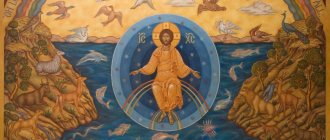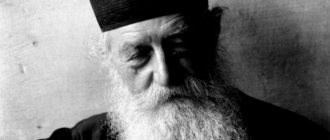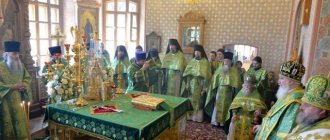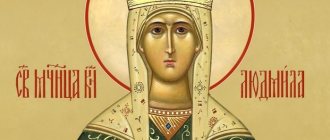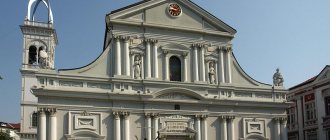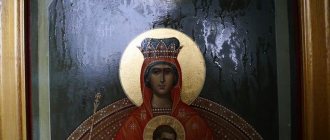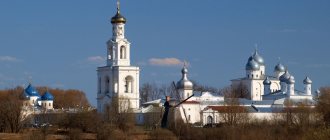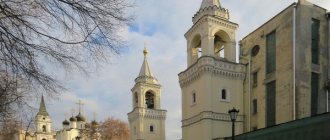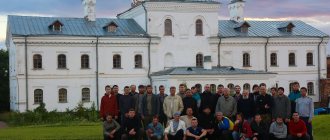Who is a rector definition?
Abbot
in the Orthodox Church - the senior cleric of a parish or monastery.
In the modern Russian Church, the rector
of the temple has the rank of archpriest (if he is a member of the white clergy) or priest.
In his activities, the rector
is accountable to the diocesan bishop. ...
Interesting materials:
Who is the founder of Kievan Rus? Who survived from the 9th company? Who finances the costs of a technical investigation into the causes of an accident at a hazardous production facility? Who carries out state environmental monitoring? Who carries out state construction supervision over reconstruction construction? Who monitors the activities of the labor protection service in the organization? Who controls the provision of paid medical services? Who monitors compliance with the procedure for investigating and recording industrial accidents? Who is in charge of control? Who implements measures to combat crime?
Lavra and monastery: what is common and what is the difference
Every monastery is a monastery. But not every monastery is a monastery. Let's say there are about eight hundred monasteries in Russia. And there are only two laurels. It’s not at all difficult to name them - Trinity-Sergiev (in Sergiev Posad) and Aleksandro-Nevskaya (in St. Petersburg).
The Lavra is certainly a large, male, outstanding monastery. Outstanding, first of all, for its significance in the history and spiritual life of the country. Lavra is a huge responsibility, a stronghold, the Grace of the Lord.
And for the monastery to grow into a monastery, it is necessary, first of all, the will of God. Then there will be an understanding among the church hierarchs, and among the laity, and among the secular authorities, they say, this is not just one of the monasteries, there is something more here... Lavra!
Let's say the Holy Trinity Lavra of St. Sergius has existed for centuries. How many spiritual deeds there are, how many souls are saved, the deeds of St. Sergius of Radonezh alone are worth something. And the status of a monastery came to the monastery only in 1742. Empress Elizaveta Petrovna signed a corresponding decree. But only two years later came the approval of the Holy Synod.
Or take the Alexander Nevsky Lavra. It emerged as a monastery at the beginning of the 18th century. Peter the First passionately revered the blessed holy prince Alexander Nevsky and ordered a monastery to be organized in his honor. The relics of the saint from Vladimir were also transported here. And the monastery became a monastery only in 1797, by decree of Paul the First. Often the Lord chooses unexpected instruments to carry out his will.
But that’s all if we talk about Russia within its current borders. There are three more laurels on the territory of modern Ukraine.
The oldest of the laurels of the Russian Orthodox Church is, of course, Kiev-Pecherskaya. The monastery on the slopes of the Dnieper appeared back in the 11th century. But he received the status of Lavra in 1688.
The Pochaev Lavra (bears this title since 1833) is the fourth in the Russian Empire. It is located in the modern Ternopil region. A stronghold of Orthodoxy in lands that are constantly encroached upon by Catholics, Uniates, and various sects.
The youngest of the laurels is the Holy Dormition Svyatogorskaya, located on the picturesque bank of the Seversky Donets. The Lavra belongs to the Donetsk diocese; it received its status in 2004 with the blessing of Patriarch Alexy II of Moscow and All Rus'.
All the monasteries mentioned, as already mentioned, are for men. This is how it happened historically. There is one convent, which, according to the prophecy of St. Seraphim of Sarov, will become the first women's monastery - Seraphim-Diveevo. True, this will happen only before the very end of the world.
MARMAZOV.RU
The material was published by the SGS website on June 19, 2017
History [edit | edit code]
Lavra could initially mean both monasteries and large parishes, whose parishioners lived in the same block (or, as they would say today, in the same city “microdistrict”).
Lavras - monasteries [edit | edit code ]
In the 4th-6th centuries in Palestine, laurels were the name given to large monasteries in which the independent life of the inhabitants was preserved (independent earning of money, handicrafts) in the presence of a joint organization of common needs (organization of divine services, construction of a wall from attacks by Bedouin nomads). This form of organization distinguished the laurels from the cenobiums, where the main principle was a “communal” structure, implying joint ownership, general distribution of labor and benefits. Later, historically and spiritually significant monasteries were called laurels, regardless of the form of residence (cenovia or idiorhythm).
Lavra - quarters [edit | edit code ]
In addition, in Alexandria of the 4th century AD. e. It was customary to call city neighborhoods (the population of which were church parishes) laurels:
“...the position of African presbyters was very different from that of their colleagues on other continents, since they had more power. In their quarters, separated from each other by boulevards (which is why they were called “laurels”), the presbyters enjoyed enormous power, as, for example, Arius was the real spiritual leader of his presbytery, Baukalis [1]."
Egypt - St. Catherine's Monastery, Spain - San Lorenzo de El Escorial
It is located on the Sinai Peninsula near Mount Sinai. This monastery is the oldest of the existing Orthodox monasteries, despite the fact that the monastery of St. Anthony also claims this title.
The Monastery of St. Catherine was built by order of Emperor Justinian I in the 6th century. At this place Moses saw a talking bush. The monastery has a huge library containing early codices and manuscripts. It outnumbers even the library in the Vatican.
Spain – San Lorenzo de El Escorial. Escorial is known all over the world. It is located in the foothills of the Sierra de Guadarrama.
During the reign of the Spanish king Philip II, this monastery was the center of political life in Spain.
Juan Bautista was appointed as the architect. This was in 1559. This architect worked in Rome. He designed St. Peter's Basilica.
Now El Escoroial is a functioning monastery, royal residence, and museum complex.
Excursion
When planning an excursion, you should take into account that part of the complex is subject to the monastery charter, while the other part (Upper) is a historical and cultural reserve. It also has several thematic museums.
The monastic monastery is open from 06:00 to 20:00, the caves can be visited from 09:00 to 16:00. The entrance is free. For a more detailed acquaintance, contact the pilgrimage department, which conducts excursions every day as groups are recruited, from 09:00 to 16:00. The program includes a viewing of the temples and buildings of the complex, caves, all accompanied by a detailed story about the saints, architectural features and main historical moments. The donation amount for an adult is 60 hryvnia, students, pensioners - 50 hryvnia, schoolchildren, disabled people - 30 hryvnia.
You can get into the reserve only with tickets: entrance - 100 hryvnia, excursion service - 120 hryvnia, individual excursion service - 1,000 hryvnia, family ticket - 240 hryvnia.
Virtual tour of the Kiev Pechersk Lavra
Economic Gate and Church of All Saints, © Anna Kudryavtseva
When will the Ukrainian Orthodox Church become autocephalous?
The unification council of Ukrainian churches will take place in the near future, but the exact date will depend on the Ecumenical Patriarch, Filaret added. At the Council, the unification of Ukrainian churches, the election of a primate and the adoption of a charter will be announced. The Primate of the Ukrainian Autocephalous Orthodox Church, Metropolitan Macarius, insists that the name, charter and model of the local Orthodox Church be agreed upon before holding the Bishops' Unification Council. He stated this in a comment to RBC-Ukraine.
Pythian games
It was these rather spectacular events that were created in honor of the god of beauty, the patron of the arts. In addition to the Pythian, the Olympic, Nemean and Isthmian were also held in Ancient Greece. It is worth saying that competitions of various kinds in the ancient empire were by no means of the least importance. The ancient Greeks competed in everything: strength, knowledge, ability to play musical instruments, and so on. They believed that the Pythian Games were not instituted by a mortal, but by Apollo himself. Initially, these were exclusively musical competitions. A laurel wreath was placed on the winner's head. This was an extremely honorable award.
The culture of Ancient Greece formed the basis of the literature and art of later states. Its influence is still felt today. The laurel wreath is an eternal symbol of victory. Even the word “laureate” comes from the name of the plant into which Apollo’s sweetheart once turned. The image of the leaves of this tree is quite often found on various medals and certificates.
Laurel structure[ | ]
Since the laurels were separate settlements or quarters within a settlement, they consisted of a number of buildings. The center of the lavra was the cathedral (katholikon), in front of which there was a courtyard. The main cathedral of the Lavra usually bears the name of one of the church holidays: Annunciation, Ascension, Trinity, Transfiguration or Assumption. The lateral extensions of the Lavra are cells (dormitory), hotel[2], bishop's house, library[3], refectory (dining room)[4], seminary[5], mallow (workshops)[6] or ancient storage (museum)[7 ]. Separately, the sacristy, baptistery and chapel were adjacent to the temple. The laurel could contain a cemetery or ossuary, as well as a garden or vegetable garden. The group of buildings was enclosed by a wall with a gate.
Current state
Currently, the brethren of the Pochaev Lavra consist of about 200 monks and 50 novices. The abbot of the monastery since 1996 is Metropolitan Vladimir (Moroz) of Pochaev, vicar of the Kyiv diocese.
A theological seminary has been operating in the monastery since 1994. There is a pilgrimage hotel and a publishing house on the territory of the monastery. The Monastery of the Holy Spirit has been operating at the Lavra since 1990 (the first information about it dates back to the 13th century; it was closed in 1960).
Every year on August 19, a religious procession takes place from the village of Dovzhok near the city of Kamenets-Podolsky to the Pochaev Lavra (20 thousand people took part in it in 2018).
Who painted the Trinity Monastery of St. Sergius?
Sergius. The temple was painted by the famous icon painters Daniil Cherny and Andrei Rublev, who created the legendary “Trinity” especially for the new cathedral. In 1469 a stone refectory was built. In 1476, to the east of the Trinity Cathedral, Pskov craftsmen erected a brick church-belfry in the name of the Descent of St.
Interesting materials:
What is a Soviet sovok? What is soviet? What are Splash masks? What are comparisons and examples? What is a comparison? Explain? What is a static IP address? What is strict mode? What is freedom of conscience and what is it based on? What is a sleep timer in music? What are customs benefits?
Alexandro-Nevskaya
This is the most famous, significant monastery in St. Petersburg, located at the end of its central avenue, Nevsky.
Holy Trinity Alexander Nevsky Lavra, St. Petersburg
Short story
It is believed that the founding date of the monastery is March 25, 1713, when its first church, Annunciation, was consecrated. However, monks who lived according to the rules of the hostel were known here earlier, from 1712. Active construction occurred in the second half of the 18th century: under Catherine II, the Trinity Cathedral was completed.
During Soviet times, the monastery was closed; a gradual revival began only in 1996.
Main shrines
Honest remains of blgv. book Alexander Nevsky and his myrrh-streaming icon, also with a particle of his relics, are shrines considered the most revered. Moreover, the image of the prince was painted in 1997, but has already been glorified by miracles.
Other venerated relics include:
Address
The address of the monastery is Embankment r. Monastyrki, 1.
Work schedule
Temples are open every day from 6 am to 8 pm.
Schedule of services
Services are usually held in Trinity Cathedral. From 5 o'clock they take place here
Daphne
What is the myth about? One of the main gods in ancient Greek legends is Apollo. He had many victories to his name, but he could not win the main one. Apollo was unable to win the heart of his beloved girl. And it all happened after a harmless joke that he allowed himself to utter at the address of Eros - a small but sometimes insidious deity, cutting through ancient Greek spaces with a golden bow in his plump hands.
The prankster directed his arrows wherever he pleased. The victims of Eros lost the ability to think about anything other than the object of their desire. Apollo once suffered from his accuracy.
An arrow that evokes love hit the heart of the god of beauty, and an arrow that rejected this feeling hit the heart of a nymph named Daphne. From now on, Apollo was destined to suffer from unrequited sympathy. Daphne not only could not respond to this feeling, but also avoided her pursuer in every possible way. One day she completely turned into a tree. Namely, in the laurel.
Apollo loved this tree very much. And since he still had many victories ahead, the inhabitants of Ancient Greece decided to use the leaves of the plant as a symbolic reward for the one who turned out to be the strongest in competitions held in honor of God.
